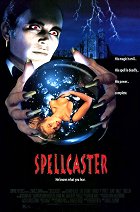Director:
Rafal ZielinskiCámara:
Sergio SalvatiMúsica:
Nathan WangReparto:
Adam Ant, Richard Blade, Bunty Bailey, Gail O'Grady, Harold Pruett, Kim Johnston Ulrich, Traci Lind, William Butler, Michael Zorek, Michael Deak, Dale WyattSinopsis(1)
The treacherous Wizard Diablo invites a gang of rock 'n roll addicts to his home for a million dollar treasure hunt. The only catch is the castle is haunted, overrun with ancient demons and gruesome spirits. (texto oficial de la distribuidora)
Reseñas (1)
On paper, Spellcaster had the potential to be a precursor to Saw, except instead of sadistic torture porn, it was supposed to be a spectacular display of practical effects motivated by the premise of a tempter Satan, who, in slasher style, disposes of a group of annoying characters by casting bizarre spells and sending rubber monsters after them. In practice, however, the film falls apart due to the fact that the filmmakers let themselves be deluded into believing in the supposed attractiveness of the setting in an Italian castle and the boundless possibilities of Dino De Laurentiis’s recently abandoned Roman studios. The sets and the environment play the main role here, but unfortunately the period bonus consisting in the fact that they helped to distinguish this film from the pile of cheap contemporary competition by lending it authentic opulence definitely no longer works from today’s perspective. The same is true of the cast, which featured popular faces from the music business of the time (pop musician Adam Ant, television VJ Richard Blade and Bunty Bailey, the face of two iconic A-Ha videos), but failed to elevate the film from today’s perspective. Unfortunately, Spellcaster mainly fails to fulfil its trashy potential, as it is stuck at the level of superficial attractions (despite the structure of the scenes, there is no nudity or gore) and, above all, it is surprisingly unable to even properly sell its tricks and special effects. Though the effects form the backbone of numerous scenes, the efforts of their creators are wasted when the director fails to adequately capture and dramatically exploit them. Spellcaster thus remains one of a number of 1980s films that are far more interesting and entertaining in witnesses’ retellings and due to the context of their creation (this was the last title from the Band brothers’ legendary Empire Pictures studio) than they are on their own merits. For that matter, it’s possible to add in the bizarre curiosity that, in terms of concept, Spellcaster is disturbingly identical to the same year’s Slaughterhouse Rock, an exercise in futility where the filmmakers also relied heavily on the power of an authentic location and drew in prominent names from the music scene. However, it is necessary to acknowledge that Spellcaster comes off as an appreciably better movie in comparison to that abortion.
()
